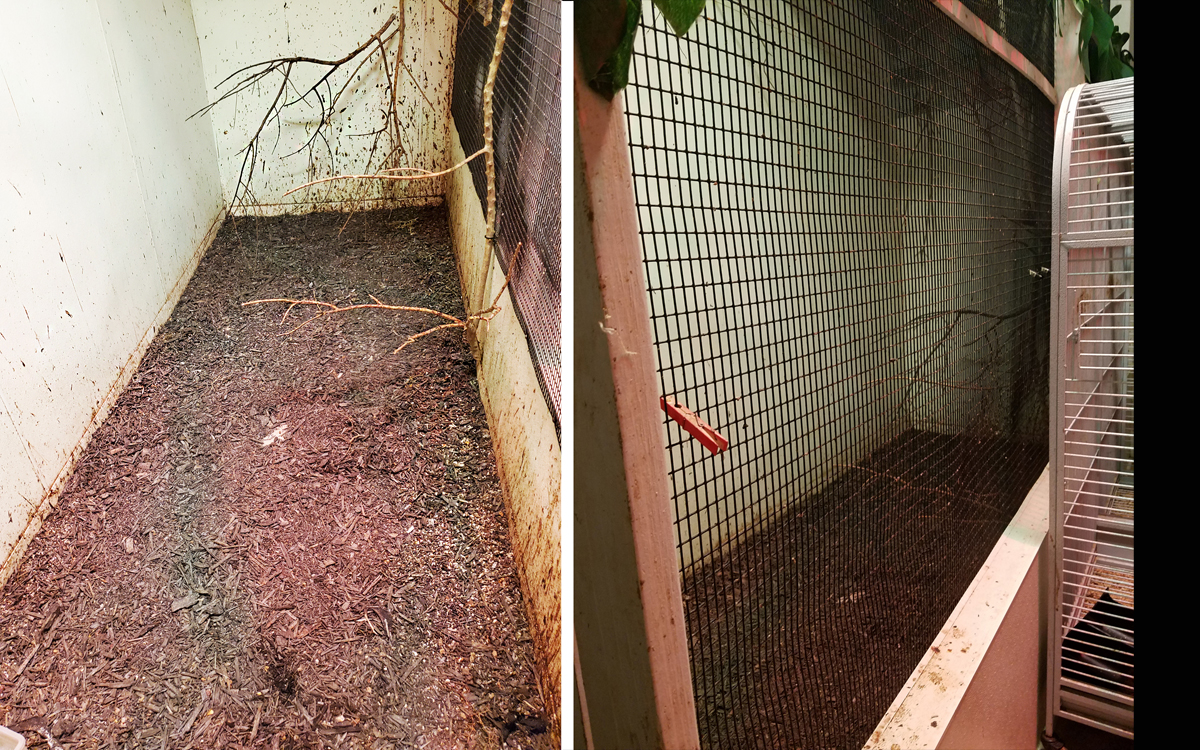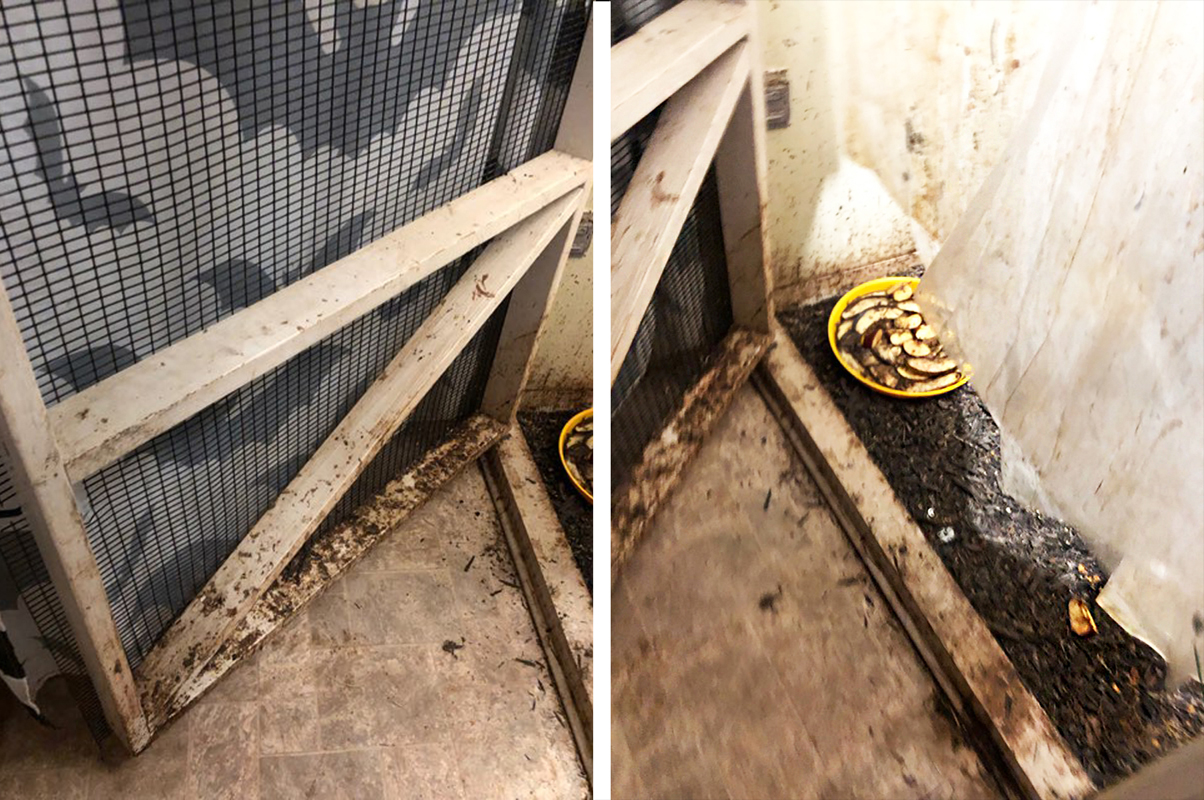In late December of 2019, an issue was brought to the attention of Bat World Sanctuary (BWS) in Texas by Second Chances Wildlife Center (SCWC) in Kentucky. The issue involved SCWC rescuing eight Egyptian fruit bats in Texas. BWS offered guidance and help as the bats were located in Texas.
On January 7th, 2020 we received a call from SCWC, who had just picked up their procured bats from what we then learned was the Mini S Exotic Zoo located in Mineola, Texas, owned by Michelle Smith. SCWC reported to us that the remaining bats at the zoo desperately needed to be rescued before they entered the pet trade. The exhibit was closing in order to make room for an anteater.
The conditions they reported at Mini S Zoo were as follows (photos below):
- 60 bats were being kept in an outbuilding (approximately 10’ x 12’), inside an enclosure that measured approximately 4’ wide by 8’ long by 10’ tall.
- No windows, natural light or fresh air was available in the small building.
- The building smelled heavily of ammonia.
- No water or fresh food was available. One dish, located on the floor, contained rotten apple slices and was contaminated with bat feces and urine. Bat dishes should always be hung from the ceiling within easy reach for bats.
- Wood shavings were on the floor, covered in excrement and urine. Roaches were visible.
- Two bats had injuries. One pitiful female Egyptian fruit bat had only one leg and that leg was severely broken and badly infected. She was so debilitated that she feebly crawled across the filthy floor, dragging her broken leg. She did not have the ability to reach the cage ceiling or her roostmates so she was condemned to live on the filthy, roach infested floor.
- SCWC asked if they could have the one-legged bat to get her medical attention. Michelle Smith denied their request and would only release the suffering bat if SCWC paid for the bat. SCWC bought the bat so she could receive the help she desperately needed.
- Aside from a few sharp twigs hanging in the cage, no enrichment was available.
SCWC took 8 bats, which left a total of 52 still needing help. This number included 10 Egyptian fruit bats and 42 Seba bats. We immediately called the zoo owner, Michelle Smith, to make arrangements to procure the remaining 52 bats. Although we never approve of purchasing bats, in order to get these bats out of their horrendous situation as quickly as possible and keep them out of the pet trade, we were forced to buy them. Michelle Smith described that the Seba bats were rare and possessed a black‐and‐white gene that could make us a “lot of money”. Michelle Smith went on to say that all of the other black and white Seba bats she had died during a “temperature crisis”, which means the bats were not provided heat or air conditioning as necessary to protect them. Michelle Smith also bragged that BWS is the only group who got adults, the others sold were all babies. All 52 bats were rescued on Thursday, Jan. 9th, 2020. The conditions at Mini S Zoo were as follows:
- The bat exhibit had the same issues as outlined above.
- The bats had already been crated when we arrived. We were told that the bats had been in the crates since Wednesday, in excess of 24 hours.
- Food was available in the crates but it appeared to have just been placed there as nothing was eaten.
- We immediately transferred the bats to our own appropriate transport carriers and gave them our own fresh food and water. The bats immediately started to devour the fresh fruit.
- One of the seba bats had an injured nose-leaf that was almost torn off. She is currently receiving treatment at BWS for her injury
- Another seba bat had her head stuck in the wire and her head was almost scalped. She is also receiving treatment at BWS for her injury.
- Some of the bats had babies and others were heavily pregnant. One anguished and apparently exhausted mother seba bat appeared to be using all of her strength to support herself and her baby on the side of an inappropriate wire cage.
- Four to five sloths were also housed in the building. They were in small, individual cages with no enrichment, food or water. One of the sloths was pacing.
While we were in the middle of our rescue, Michelle Smith informed us that she had sold a young female bat from the group of Egyptians to a man in Missouri. Our hearts sank at this knowledge. Egyptian fruit bats form very strong family units for life. Offspring stay with their mothers for up to two years. We pressed Michelle, on a daily basis, in order to obtain the buyers contact information and we finally received it almost a week later. We then made arrangements to also get this one lone pup from MO to TX and thankfully, she is now with us and back with her family.
At Mini S Exotic Zoo, no consideration was ever given to these bats other than what profit can be made off of them. The animals we observed were confined to a dark, windowless outbuilding with no fresh air, food or water and nothing whatsoever to occupy their intelligent minds. But more is to fault besides animal dealers like Michelle Smith. USDA’s Animal and Plant Health Inspection Service (APHIS) is sorely lacking in minimum standards for bats in particular, enabling places like the Mini S Exotic Zoo to get away with the mistreatment of bats. The Association of Zoos and Aquariums (AZA) is also to blame in that some of these zoos, even the accredited ones, allow bats to over-breed and then leak the excess into the pet trade as well as research.
Please join us in sending a message to both the USDA and the AZA
that leaking bats into research and the pet trade must stop!
Photo Evidence





We are so appreciative that we were in a position to get these suffering, abused bats to safety and out of harm’s way. The males have been neutered and the mothers are being allowed to raise their babies and keep them for life. Many of the bats are still very frightened so our focus is making sure these beautiful beings understand they will not be going anywhere else; they truly are safe in their forever home with dozens of others just like them. They will be able to fly freely in indoor-outdoor enclosures and eat all of the nourishing food their little bellies can hold. We have been offered two matching grants totaling $15,000 if we can raise that same amount. Please help us help these bats, and all the others still waiting to be rescued by donating here:


